Zoo

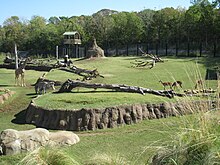
A zoo (short for zoological park or zoological garden, and also called a menagerie) is a facility in which animals are confined within enclosures, displayed to the public, and in which they may also be bred.
The term zoological garden refers to zoology, the study of animals, a term deriving from the Greek zōon (ζῷον, "animal") and lógos (λóγος, "study"). The abbreviation "zoo" was first used of the London Zoological Gardens, which opened for scientific study in 1828 and to the public in 1847.[1] The number of major animal collections open to the public around the world now exceeds 1,000, around 80 percent of them in cities.[2]
Zoos typically house more wild animals than domesticated ones.
Etymology
London Zoo, which opened in 1828, first called itself a menagerie or "zoological garden," which is short for "Gardens and Menagerie of the Zoological Society of London."[3] The abbreviation "zoo" first appeared in print in the UK around 1847, when it was used for the Clifton Zoo, but it was not until some 20 years later that the shortened form became popular in the song "Walking in the Zoo on Sunday" by music-hall artist Alfred Vance.[3] The term "zoological park" was used for more expansive facilities in Washington, D.C., and the Bronx in New York, which opened in 1891 and 1899 respectively.[4]
Relatively new terms for zoos coined in the late 20th century are "conservation park" or "biopark". Adopting a new name is a strategy used by some zoo professionals to distance their institutions from the stereotypical and nowadays criticized zoo concept of the 19th century.[5] The term "biopark" was first coined and developed by the National Zoo in Washington D.C. in the late 1980s.[6] In 1993, the New York Zoological Society changed its name to the Wildlife Conservation Society and rebranded the zoos under its jurisdiction as "wildlife conservation parks."[7]
History
Ancient world
The predecessor of the zoological garden is the menagerie, which has a long history from the ancient world to modern times. The oldest known zoological collection was revealed during excavations at Hierakonpolis, Egypt in 2009, of a ca. 3500 B.C. menagerie. The exotic animals included hippos, hartebeest, elephants, baboons and wildcats.[8] King Ashur-bel-kala of the Middle Assyrian Empire created Zoological and Botanical Gardens in the 11th Century BC. In the 2nd century BCE, the Chinese Empress Tanki had a "house of deer" built, and King Wen of Zhou kept a 1,500-acre (6.1 km2) zoo called Ling-Yu, or the Garden of Intelligence. Other well-known collectors of animals included King Solomon of the Kingdom of Israel and Judah, queen Semiramis and king Ashurbanipal of Assyria, and King Nebuchadnezzar of Babylonia.[2] By the 4th century BCE, zoos existed in most of the Greek city states; Alexander the Great is known to have sent animals that he found on his military expeditions back to Greece. The Roman emperors kept private collections of animals for study or for use in the arena,[2] the latter faring notoriously poorly. The 19th-century historian W.E.H. Lecky wrote of the Roman games, first held in 366 BCE:
At one time, a bear and a bull, chained together, rolled in fierce combat across the sand ... Four hundred bears were killed in a single day under Caligula ... Under Nero, four hundred tigers fought with bulls and elephants. In a single day, at the dedication of the Colosseum by Titus, five thousand animals perished. Under Trajan ... lions, tigers, elephants, rhinoceroses, hippopotami, giraffes, bulls, stags, even crocodiles and serpents were employed to give novelty to the spectacle ...[9]
Medieval England
Henry I of England kept a collection of animals at his palace in Woodstock, which reportedly included lions, leopards, and camels.[10] The most prominent collection in medieval England was in the Tower of London, created as early as 1204 by King John I. Henry III received a wedding gift in 1235 of three leopards from Frederick II, Holy Roman Emperor, and in 1264, the animals were moved to the Bulwark, renamed the Lion Tower, near the main western entrance of the Tower. It was opened to the public during the reign of Elizabeth I in the 16th century.[11] During the 18th century, the price of admission was three half-pence, or the supply of a cat or dog for feeding to the lions.[10] The animals were moved to the London Zoo when it opened.
Modern era

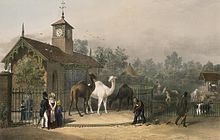
The oldest zoo in the world still in existence is the Tiergarten Schönbrunn in Vienna, Austria. It was constructed by Adrian van Stekhoven in 1752 at the order of the Holy Roman Emperor Francis I, husband of Maria Theresa of Austria, to serve as an imperial menagerie as part of Schönbrunn Palace. The menagerie was initially reserved for the viewing pleasure of the imperial family and the court, but was made accessible to the public in 1765.
In 1775, a zoo was founded in Madrid, and in 1795, the zoo inside the Jardin des Plantes in Paris was founded by Jacques-Henri Bernardin, with animals from the royal menagerie at Versailles, primarily for scientific research and education. The Kazan Zoo, the first zoo in Russia was founded in 1806 by the Professor of Kazan State University Karl Fuchs. The Zoological Society of London, founded in 1826 by Stamford Raffles, adopted the idea of the Paris zoo when they established the London Zoo in Regent's Park in 1828, which opened to paying visitors in 1847.[2] Dublin Zoo was opened in 1831 by members of the medical profession interested in studying animals while they were alive and more particularly getting hold of them when they were dead.[12] The first zoological garden in Australia was Melbourne Zoo in 1860. In the same year, Central Park Zoo, the first public zoo in the United States, opened in New York, although in 1859, the Philadelphia Zoological Society had made an effort to establish a zoo, but delayed opening it until 1874 because of the American Civil War.
The zoo in Thiruvananthapuram, Kerala, India is one of the oldest in the country, and was established as an adjunct to the Museum in 1857 by the erstwhile Maharaja of Travancore in order to attract more visitors. Lahore Zoo in Lahore, Pakistan was established in 1872 by a local philanthropist Lal Mahundra Ram and Lahore Municipal Corporation.
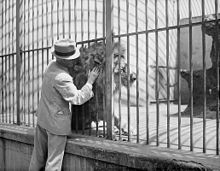
In 1907, the German entrepreneur Carl Hagenbeck founded the Tierpark Hagenbeck in Stellingen, now a quarter of Hamburg. It is known for being the first zoo to use open enclosures surrounded by moats, rather than barred cages, to better approximate animals' natural environments.[13]
When ecology emerged as a matter of public interest in the 1970s, a few zoos began to consider making conservation their central role, with Gerald Durrell of the Jersey Zoo, George Rabb of Brookfield Zoo, and William Conway of the Bronx Zoo (Wildlife Conservation Society) leading the discussion. From then on, zoo professionals became increasingly aware of the need to engage themselves in conservation programs, and the American Zoo Association soon said that conservation was its highest priority.[14] Because they wanted to stress conservation issues, many large zoos stopped the practice of having animals perform tricks for visitors. The Detroit Zoo, for example, stopped its elephant show in 1969, and its chimpanzee show in 1983, acknowledging that the trainers had probably abused the animals to get them to perform.[15]
Human exhibits
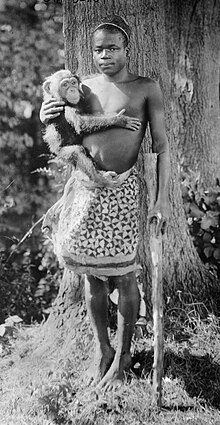
Human beings were sometimes displayed in cages along with non-human animals, supposedly to illustrate the differences between people of European and non-European origin. In September 1906, William Hornaday, director of the Bronx Zoo in New York—with the agreement of Madison Grant, head of the New York Zoological Society—had Ota Benga, a Congolese pygmy, displayed in a cage with the chimpanzees, then with an orangutan named Dohong, and a parrot. The exhibit was intended as an example of the "missing link" between the orangutan and white man. It triggered protests from the city's clergymen, but the public reportedly flocked to see it.[16][17]
Human beings were also displayed in cages during the 1931 Paris Colonial Exposition, and as late as 1958 in a "Congolese village" display at Expo '58 in Brussels.[18]
Appearance and type
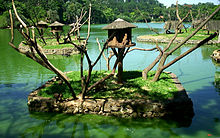
Zoo animals usually live in enclosures that attempt to replicate their natural habitats, for the benefit of the animals and the visitors. They may have special buildings for nocturnal animals, with dim white or red lighting used during the day, so the animals will be active when visitors are there, and brighter lights at night to help them sleep. Special climate conditions are created for animals living in radical environments, such as penguins. Special enclosures for birds, insects, reptiles, fish, and other aquatic life forms have also been developed. Some zoos have walk-through exhibits where visitors enter enclosures of non-aggressive species, such as lemurs, marmosets, birds, lizards, and turtles. Visitors are asked to keep to paths and avoid showing or eating foods that the animals might snatch.
Open-range zoos
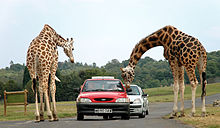
Some zoos keep fewer animals in larger, outdoor enclosures, confining them with moats and fences, rather than in cages. Safari parks, also known as zoo parks and lion farms, allow visitors to drive through them and come in close contact with the animals.[2] The first of this kind of zoo was Whipsnade Park in Bedfordshire, England, opened by the Zoological Society of London in 1931, and covering 600 acres (2.4 km²). Since the early 1970s, a 1,800 acre (7 km²) park in the San Pasqual Valley near San Diego has featured the San Diego Zoo Safari Park, run by the Zoological Society of San Diego. One of two state-supported zoo parks in North Carolina is the 2,000-acre (8.1 km2) North Carolina Zoo in Asheboro.[19] The 500-acre (2.0 km2) Werribee Open Range Zoo in Melbourne, Australia, displays animals living in a savannah.
Public aquaria
The first public aquarium was opened in London Zoo in 1853. This was followed by the opening of public aquaria in continental Europe (for example, Paris 1859, Hamburg 1864, Berlin 1869, Brighton 1872) and the United States (Boston 1859, Washington 1873, San Francisco Woodward's Garden 1873, New York Battery Park 1896). In 2005 the non-profit Georgia Aquarium with more than 8 million US gallons (30,000 m³; 30,000,000 litres) of marine and fresh water, and more than 100,000 animals of 500 different species opened in Atlanta, Georgia. The aquarium's specimens include whale sharks and beluga whales.
Roadside zoos
Roadside zoos are found throughout North America, particularly in remote locations. They are small, unregulated, for-profit zoos, often intended to attract visitors to some other facility, such as a gas station. The animals may be trained to perform tricks, and visitors are able to get closer to them than in larger zoos.[20] Since they are sometimes less regulated, roadside zoos are often subject to accusations of neglect[21] and cruelty.[22]
Petting zoos
A petting zoo, also called children's farms or children's zoos, features a combination of domestic animals and wild species that are docile enough to touch and feed. To ensure the animals' health, the food is supplied by the zoo, either from vending machines or a kiosk nearby.
Animal theme parks
An animal theme park is a combination of an amusement park and a zoo, mainly for entertaining and commercial purposes. Marine mammal parks such as Sea World and Marineland are more elaborate dolphinariums keeping whales, and containing additional entertainment attractions. Another kind of animal theme park contains more entertainment and amusement elements than the classical zoo, such as a stage shows, roller coasters, and mythical creatures. Some examples are Busch Gardens Tampa Bay in Tampa, Florida, Disney's Animal Kingdom in Orlando, Florida, Flamingo Land in North Yorkshire, England and Six Flags Discovery Kingdom in Vallejo, California .
Sources and care of animals

When they arrive at the zoo, the animals are placed in quarantine, and slowly acclimatized to enclosures which seek to mimic their natural environment. For example, some species of penguins may require refrigerated enclosures. Guidelines on necessary care for such animals is published in the International Zoo Yearbook.[23]
Conservation and research

The position of most modern zoos in Australasia, Europe, and North America, particularly those with scientific societies, is that they display wild animals primarily for the conservation of endangered species, as well as for research purposes and education, and secondarily for the entertainment of visitors,[24][25] an argument disputed by critics. The Zoological Society of London states in its charter that its aim is "the advancement of Zoology and Animal Physiology and the introduction of new and curious subjects of the Animal Kingdom." It maintains two research institutes, the Nuffield Institute of Comparative Medicine and the Wellcome Institute of Comparative Physiology. In the U.S., the Penrose Research Laboratory of the Philadelphia Zoo focuses on the study of comparative pathology.[2] The World Association of Zoos and Aquariums produced its first conservation strategy in 1993, and in November 2004, it adopted a new strategy that sets out the aims and mission of zoological gardens of the 21st century.[26]
The breeding of endangered species is coordinated by cooperative breeding programmes containing international studbooks and coordinators, who evaluate the roles of individual animals and institutions from a global or regional perspective, and there are regional programmes all over the world for the conservation of endangered species.[27]
Surplus animals
To reduce the need for animals from the wild, the breeding of animals within zoos is encouraged.[23] Eric Baratay and Elisabeth Hardouin-Fugier of the Université Jean-Moulin, Lyon, say that the overall "stock turnover" of animals is one-fifth to one-fourth over the course of a year—with three-quarters of wild caught apes dying in captivity within the first twenty months. They say that before successful breeding programs, the high mortality rate is the reason for the "massive scale of importations."[29]
The downside to breeding the animals in captivity is that over time, without additional genetic material from the wild, all the animals in captivity can become related. The San Jose Mercury News conducted a two-year study that suggested of the 19,361 certain species of mammals that left accredited zoos in the U.S. between 1992 and 1998, 7,420 (38 percent) went to dealers, auctions, hunting ranches, unaccredited zoos and individuals, and game farms.[30]
Condition of the animals


The condition of the animals varies widely, especially in zoos in countries with little or no regulations. The majority of zoos continue to work to improve their animal enclosures, although constraints like size and expense make it difficult to create ideal captive environments for some species, such as dolphins and whales.[32][33]

Some critics argue that animals that live in zoos are treated as voyeuristic objects rather than living creatures, and are often driven to insanity in the transition from being free and wild to incarcerated and dependent on humans for survival.[34]
A four-decade Oxford University study found that polar bears, lions, tigers, and cheetahs show the most evidence of stress in captivity.[35]
Live feeding
feeding by visitors is often discouraged. However, in the Badaltearing Safari Park in China, zoo visitors can throw live goats into the lions' enclosure and watch them being eaten, or can purchase live chickens tied to bamboo rods for the equivalent of 2 dollars\euros to dangle into lion pens. Visitors can drive through the lion's compound on buses with specially designed chutes leading into the enclosure into which they can push live chickens. In the Xiongsen Bear and Tiger Mountain Village near Guilin in south-east China, live cows and pigs are thrown to tigers to amuse visitors.[36][37] In the Qingdao zoo, visitors engage in "tortoise baiting", where tortoises are kept inside small rooms with elastic bands round their necks, so that they are unable to retract their heads. Visitors then throw coins at them. The marketing claim is that if you hit one of them on the head and make a wish, it will be fulfilled.[36]
Regulation of zoos
United States
In the United States, any public animal exhibit must be licensed and inspected by the United States Department of Agriculture, United States Environmental Protection Agency, Drug Enforcement Administration, Occupational Safety and Health Administration, and others. Depending on the animals they exhibit, the activities of zoos are regulated by laws including the Endangered Species Act, the Animal Welfare Act, the Migratory Bird Treaty Act of 1918 and others.[38] Additionally, zoos in North America may choose to pursue accreditation by the Association of Zoos and Aquariums (AZA). To achieve accreditation, a zoo must pass an application and inspection process and meet or exceed the AZA's standards for animal health and welfare, fundraising, zoo staffing, and involvement in global conservation efforts. Inspection is performed by three experts (typically one veterinarian, one expert in animal care, and one expert in zoo management and operations) and then reviewed by a panel of twelve experts before accreditation is awarded. This accreditation process is repeated once every five years. The AZA estimates that there are approximately 2,400 animal exhibits operating under USDA license as of February 2007; fewer than 10% are accredited.[39]
Europe
In April 1999, the European Union introduced a directive to strengthen the conservation role of zoos, making it a statutory requirement that they participate in conservation and education, and requiring all member states to set up systems for their licensing and inspection.[40] Zoos are regulated in the UK by the Zoo Licensing Act of 1981, which came into force in 1984. A zoo is defined as any "establishment where wild animals are kept for exhibition ... to which members of the public have access, with or without charge for admission, seven or more days in any period of twelve consecutive months," excluding circuses and pet shops. The Act requires that all zoos be inspected and licensed, and that animals kept in enclosures are provided with a suitable environment in which they can express most normal behavior.[40]
See also
| Conservation status |
|---|
| Extinct |
| Threatened |
| Lower Risk |
| Other categories |
| Related topics |
 Comparison of Red List classes above and NatureServe status below  |
- List of zoos
- List of zoo associations
- Animals in captivity
- Conservation
- Extinction
- Zoo Emergency Response Team
- Zoology (includes a list of prominent zoologists)
- Immersion exhibit
- Frozen Zoo
Notes
- ^ "ZSL's history", Zoological Society of London.
- ^ a b c d e f "Zoo," Encyclopaedia Britannia, 2008.
- ^ a b Blunt 1976; Reichenbach 2002, pp. 151–163.
- ^ Hyson 2000, p. 29; Hyson 2003, pp. 1356-1357.
- ^ Maple 1995, p. 25.
- ^ Robinson 1987a, pp. 10-17; Robinson 1987b, pp. 678-682.
- ^ Conway 1995, pp. 259-276.
- ^ World's First Zoo - Hierakonpolis, Egypt, Archaeology Magazine, http://www.archaeology.org/1001/topten/egypt.html
- ^ Lecky, W.E.H. History of European Morals from Augustus to Charlemagne. Vol. 1, Longmans, 1869, pp. 280-282.
- ^ a b Blunt, Wilfred. The Ark in the Park: The Zoo in the Nineteenth Century. Hamish Hamilton, 1976, pp. 15-17.
- ^ "Big cats prowled London's tower", BBC News, October 24, 2005.
- ^ Costello, John (June 9, 2011). "The great zoo's who". Irish Independent.
- ^ Rene S. Ebersole (2001). "The New Zoo". Audubon Magazine. National Audubon Society. Retrieved 2007-12-18.
{{cite news}}: Unknown parameter|month=ignored (help) - ^ See Kisling, Vernon N. (ed.): Zoo and Aquarium History, Boca Raton 2001. ISBN 0-8493-2100-X; Hoage, R. J. Deiss and William A. (ed.): New Worlds, New Animals, Washington 1996. ISBN 0-8018-5110-6; Hanson, Elizabeth. Animal Attractions, Princeton 2002. ISBN 0-691-05992-6; and Hancocks, David. A Different Nature, Berkeley 2001. ISBN 0-520-21879-5
- ^ Donahue, Jesse and Trump, Erik. Political Animals: Public Art in American Zoos and Aquariums. Lexington Books, 2007, p. 79.
- ^ Bradford, Phillips Verner and Blume, Harvey. Ota Benga: The Pygmy in the Zoo. St. Martins Press, 1992.
- ^ "Man and Monkey Show Disapproved by Clergy", The New York Times, September 10, 1906.
- ^ Blanchard, Pascal; Bancel, Nicolas; and Lemaire, Sandrine. "From human zoos to colonial apotheoses: the era of exhibiting the Other", Africultures.
- ^ Ferral, Katelyn (2010-07-15). "N.C. Zoo, bucking a trend, sets an attendance record". Newsobserver.com. Retrieved 2013-05-04.
- ^ Guzoo Animal Farm, website about Canadian roadside zoos, accessed June 18, 2009.
- ^ Roadside zoo animals starving. Free Lance-Star. 11 Jan. 1997.
- ^ Dixon, Jennifer. House panel told of abuses by zoos. Times Daily. 8 July 1992.
- ^ a b "Zoo: Procurement and care of animals," Encyclopaedia Britannica, 2008.
- ^ Tudge, Colin. Last Animals in the Zoo: How Mass Extinction Can Be Stopped, London 1991. ISBN 1-55963-157-0
- ^ "Manifesto for Zoos", John Regan Associates, 2004.
- ^ "World Zoo and Aquarium Conservation Strategy", World Association of Zoos and Aquariums.
- ^ In Africa, conservation is handled by the African Preservation Program APP (African Association of Zoological Gardens and Aquaria; in the U.S. and Canada by Species Survival Plans (American Zoo and Aquarium Association), and the Canadian Association of Zoos and Aquariums); in Australasia, by the Australasian Species Management Program (Australasian Regional Association of Zoological Parks and Aquaria); in Europe, by the European Endangered Species Program (European Association of Zoos and Aquaria); and in Japan, South Asia, and South East Asia, by the Japanese Association of Zoos and Aquariums, the South Asian Zoo Association for Regional Cooperation, and the South East Asian Zoo Association.
- ^ "Amarillo Wildlife Refuge", PETA.
- ^ Jensen, Derrick and Tweedy-Holmes Karen. Thought to Exist in the Wild: Awakening from the Nightmare of Zoos. No Voice Unheard, 2007, p. 21; Baratay, Eric and Hardouin-Fugier, Elisabeth. Zoo: A History of the Zoological Gardens of the West. Reaktion, London. 2002.
- ^ Goldston, Linda. February 11, 1999, cited in Scully, Matthew. Dominion. St. Martin's Griffin, 2004 (paperback), p. 64.
- ^ "Zigong Zoo « AAPN". Aapn.org. Retrieved 2013-05-04.
- ^ Norton, Bryan G.; Hutchins, Michael; Stevens, Elizabeth F.; Maple, Terry L. (ed.): Ethics on the Ark. Zoos, Animal Welfare, and Wildlife Conservation. Washington, D.C., 1995. ISBN 1-56098-515-1
- ^ Malmud, Randy. Reading Zoos. Representations of Animals and Captivity. New York, 1998. ISBN 0-8147-5602-6
- ^ Jensen, p. 48.
- ^ Derr, Mark. “Big Beasts, Tight Space and a Call for Change in Journal Report,” The New York Times, October 2, 2003.
- ^ a b Penman, Danny. "Animals torn to pieces by lions in front of baying crowds: the spectator sport China DOESN'T want you to see", The Daily Mail, January 1, 2008.
- ^ Ferocity Training, Sunday Morning Post, Hong Kong, November 29, 1999.
- ^ Grech, Kali S. "Overview of the Laws Affecting Zoos", Michigan State University College of Law, Animal Legal & Historical Center, 2004.
- ^ AZA Accreditation Introduction[dead link]
- ^ a b "The Zoo Licensing Act 1981", Department for Environment, Food, and Rural Affairs.
References
- Blunt, Wilfrid (1976). The Ark in the Park: The Zoo in the Nineteenth Century, Hamish Hamilton, London. ISBN 0-241-89331-3
- Braverman, Irus (2012). Zooland: The Institution of Captivity, Stanford University Press, Stanford. ISBN 9780804783576.
- Conway, William (1995). "The conservation park: A new zoo synthesis for a changed world", in The Ark Evolving: Zoos and Aquariums in Transition, Wemmer, Christen M. (ed.), Smithsonian Institution Conservation and Research Center, Front Royal, Virginia.
- Hyson, Jeffrey (2000). "Jungle of Eden: The Design of American Zoos" in Environmentalism in Landscape Architecture, Conan, Michel (ed.), Dumbarton Oaks, Washington. ISBN 0-88402-278-1
- Hyson, Jeffrey (2003). "Zoos," in Encyclopedia of World Environmental History: O-Z, Krech, Shepard, Mc Neill, John Robert and Merchant, Carolyn (ed.), Routledge, London. ISBN 0-415-93735-3
- Maple, Terry (1995). "Toward a Responsible Zoo Agenda", in Ethics on the Ark: Zoos, Animal Welfare, and Wildlife Conservation, Norton, Bryan G., Hutchins, Michael, Stevens, Elizabeth F. and Maple, Terry L. (ed.), Smithsonian Institution Press, Washington. ISBN 1-56098-515-1
- Reichenbach, Herman (2002). "Lost Menageries: Why and How Zoos Disappear (Part 1)", International Zoo News Vol.49/3 (No.316), April–May 2002.
- Robinson, Michael H. (1987a). "Beyond the zoo: The biopark", Defenders of Wildlife Magazine, Vol. 62, No. 6.
- Robinson, Michael H. (1987b). "Towards the Biopark: The Zoo That Is Not", American Association of Zoological Parks and Aquariums, Annual Proceedings.
External links
- Zoos Worldwide Zoos, aquariums, animal sanctuaries and wildlife parks
- Zoological Gardens keeping Asian Elephants
- The Bartlett Society: Devoted to stydying yesterday's methods of keeping wild animals, download page
